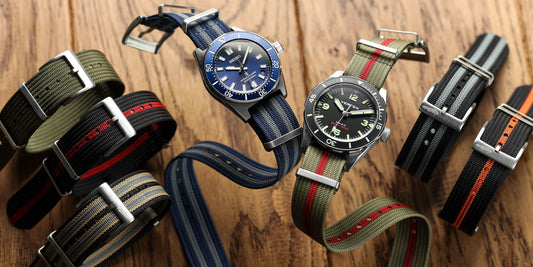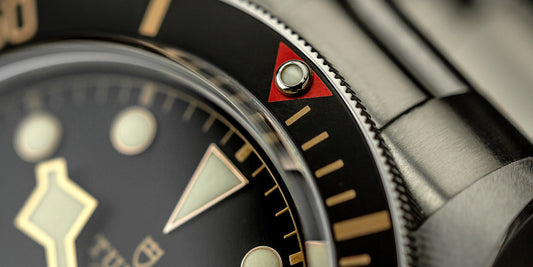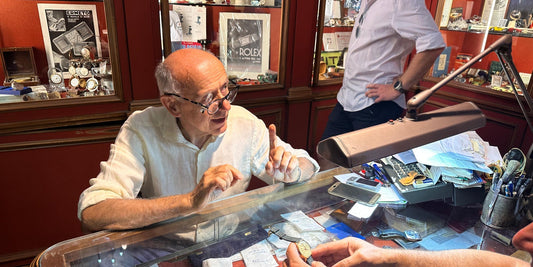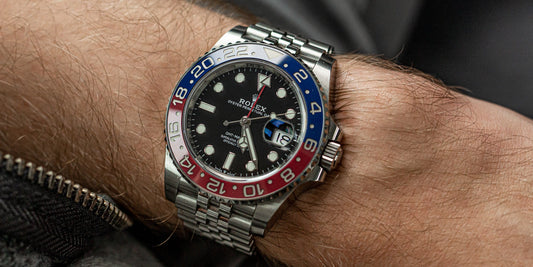Getting Back To The Roots Of The Heuer Carrera
In 1963, Heuer introduced the famous Carrera, which was designed by Jack Heuer (the grandson of company founder Edouard). It was a reasonably simple yet instantly recognisable chronograph in terms of design, with three registers on the dial, plus markers instead of numbers on the face. Clearly inspired by the (recently re-issued) Autavia that came out a year before it, the Carrera was an instant classic: which then went on to become one of Heuer’s most celebrated models, with several variations in terms of colours and design.
But why the name Carrera? The answer lies in Heuer’s heritage, which always had a strong background in cars and motorsport. In 1911, the company produced its very first dashboard chronograph, while in the 1960s it was the very first watch company to really embrace motorsport sponsorship as a business model. Probably the most well-known example was the Monaco, famously worn by Steve McQueen in the 1971 ‘Le Mans’ film, which immediately established this square timepiece as an icon.
For a number of years, Heuer had been naming watches after famous racing circuits: as well as the Monaco there was the Silverstone, Daytona, Montreal (to this author’s eyes, actually the most desirable of the lot) and Jarama – to name but a few. The Carrera tag (no pun intended) is a bit different. It actually celebrates one of the world’s toughest, but comparatively little-known, races: the Carrera Panamericana, which used to run across Mexico. The ‘Carrera’, as it was simply known, was an old-fashioned road race that favoured only the brave, where every second counted. For a watchmaker, it was a natural fit.
The race was first held in 1950 to promote the fact that the Mexican section of the Panamerican Highway (a road that runs through the entirety of Central and South America) had been completed. To bring people’s attention to that fact, Mexico’s government came up with a five-day rally that covered more than 2000 flat-out miles. As an advertising concept, it was an interesting one: probably similar to a brewery deciding to host a week-long nationwide drinking contest to celebrate the arrival of a newly-launched beer. But things were very different back then, and Mexico was reasonably lawless. Some would argue that it still is…
The original entry list consisted of 132 competitors made up of amateurs as well as professionals. A handful of them were even local taxi drivers, aiming to supplement their meagre incomes with the winner’s prize of $17,000: an unthinkable amount in the 1950s. At the time, you could buy a new Rolex Submariner for around $150. Back then, the Carrera Panamericana was considered to be one of the most dangerous races in the world. Seat belts and roll cages were optional while a death wish was to some extent mandatory. It was true gladiatorial combat.
Local driver Jose Estrada, a veteran racer and Mexico City car dealer, declared before the 1951 race: “I’m going to win to win or die trying.” Let’s just say that he didn’t win, but at least he met half of his targets. And he wasn’t the only one. Not even the top Formula 1 drivers of the time, attracted by the challenge, were safe. Italian Formula 1 driver Felice Bonetto was killed after crashing out of the lead of the 1953 Carrera Panamericana when his Lancia hit a pavement and struck a building: one of 27 people to die on the event in its five-year history.
A more unusual accident occurred the year before when the Mercedes 300 SL of Karl Kling hit a vulture at around 120mph, which came straight through the windscreen. Although co-driver Hans Klenk was briefly knocked unconscious by the impact, Kling and Klenk went on to take what was probably one of the most heroic victories in the history of motorsport. By the end of it, they were quite literally spitting feathers.
The last Carrera Panamericana before the event was unsurprisingly banned was run in 1954, with the winning Ferrari driven by Umberto Maglioli recording a hair-raising average speed of 138mph. And this was more than 65 years ago…
That was a huge part of the appeal for Heuer, who wanted to design a watch that broke traditional boundaries. The mission of the Carrera timepiece was to reflect that unquenchable need for speed while offering robust and reliable performance: two cornerstones of the Carrera Panamericana. Heuer weren’t the only people to be inspired by the event: Porsche also named its famous family of sports cars ‘Carrera’, despite never actually winning the race outright.
But the story didn’t finish there. In 1988, the Carrera Panamericana was revived after a 34-year absence (in diluted form), then in 2015 it became an international event once more. TAG Heuer was the partner and official timekeeper for the event, rekindling an age-old association. To mark the occasion, the company produced the special edition Carrera Panamericana, featuring the official race logo on the case back. That’s one of the most collectable of all the Carreras, which have been an enduring icon of the TAG Heuer range for more than the last 50 years. Other special editions have been created to celebrate the launch of the McLaren MP4-12C in 2011, for example, while the family also produced the Grand Carrera: a bigger watch that draws inspiration from the classic Carrera, along with some more modern features.
The great thing about collecting watches is that everyone has their own preferences. Personally, the Grand Carrera convinces me less because it’s a bit too far removed from its origins, but other people will see just a striking and easy to read timepiece that is a natural evolution of the original concept.
However, it all goes back to that fearsome old road race in Mexico, which is still going now as a classic car rally – with this year’s edition finishing only a couple of weeks ago. These days it’s mostly contested by old American cars – a Studebaker won this time – with a smattering of Porsche 911s as well, not to mention the occasional Ford, BMW and Buick. To win, the cars still need to be strong and reliable: just like the Heuer watches named after this notorious test of man and machine. Most watches have a great story behind them, which is one of the reasons why we love them, but this tale is particularly special.






















